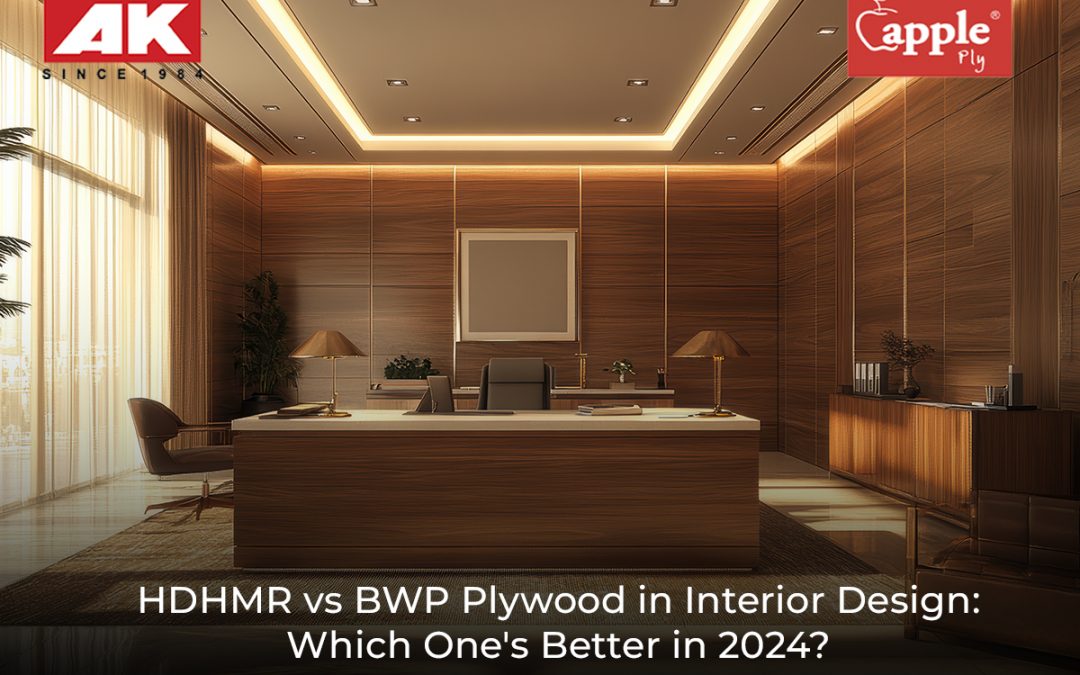When it comes to transforming interiors, choosing the right material is more than just a design decision, it’s all about creating a space that lasts. Enter the debate between HDHMR (High-Density High Moisture Resistance) and BWP (Boiling Water Proof) plywood, two popular choices that bring unique qualities to the table.
But which one is the best for you in 2024? Read through the entire blog to know your ideal choice!
Discover how these expertly crafted plywood options can elevate your interiors, offering the perfect balance of aesthetics, durability, and value in 2024 and beyond.
What is HDHMR?
HDHMR (High-Density High Moisture Resistance) is a strong and versatile engineered wood product, known for its high density and enhanced moisture resistance nature. Made from a mix of hardwood fibers, HDHMR boards offer greater strength, making them the perfect choice for furniture and cabinetry that are frequently used or come in contact with moisture.
This material is especially gaining popularity in modern interior design for its durability, long-lasting performance, and ability to withstand wear and tear.
What is BWP Plywood?
BWP (Boiling Waterproof) Plywood is a premium plywood type known for its superior water resistance. Crafted using high-quality wood veneers bonded with phenolic resins, BWP plywood is specifically designed to withstand continuous exposure to water without degrading or losing its structural integrity. This makes it an excellent choice for areas with high humidity, such as kitchens and bathrooms, or for outdoor applications where exposure to moisture is inevitable.
HDHMR vs. BWP Plywood in Interior Design: The Plywood Debate of 2024
1. Strength and Durability
- HDHMR: Made from hardwood fibers compressed under high pressure, HDHMR boards are denser and stronger than BWP plywood. This high-density feature of HDHMR, makes it ideal for heavy-use furniture, such as kitchen cabinets, wardrobes, and countertops. HDHMR is perfect to provide superior strength and can withstand regular wear and tear as well!
- BWP Plywood: BWP plywood also offers major durability but is relatively less dense than HDHMR. It is still strong enough for most interior applications and performs incredibly well in environments where exposure to moisture is a concern.
2. Moisture Resistance
- HDHMR: HDHMR(High-Density High Moisture Resistance) as the name itself suggests, is known for its excellent moisture resistance qualities. They offer high moisture resistance due to their density and uniform composition, making them ideal for areas prone to dampness or high humidity, such as bathrooms and kitchens. The compact fibres ensure minimal water absorption, which in turn prevents swelling, warping, or decay in the long run.
- BWP Plywood: BWP (Boiling Water Proof) plywood is specifically designed to endure direct water exposure. They use phenolic resins that offer excellent resistance to moisture. Unlike HDHMR, BWP plywood is specifically engineered for outdoors making them highly suitable for places with extreme humidity.
3. Versatility and Aesthetics
- HDHMR: The smooth and uniform surface of HDHMR boards allows for a variety of finishes, including paint, laminates, and veneers. This makes them highly versatile for achieving modern and contemporary designs. HDHMR is also easier to cut, shape, and mold, providing more flexibility in design applications.
- BWP Plywood: While BWP plywood is versatile in its use, its aesthetics may not match the level of smoothness provided by HDHMR. It can still be polished, painted, or veneered but is mostly preferred by people for its functional benefits (like water resistance) rather than its design flexibility.
You might also be interested in reading about the top 10 premium quality veneer manufacturers in India.
4. Cost and Affordability
- HDHMR: Generally, HDHMR boards are considered to be more cost-effective than BWP Plywood, especially for indoor applications. Due to their unique structure and composition, they offer an economical solution for those looking for strength and durability without a high price tag.
- BWP Plywood: BWP plywood tends to be more expensive due to the high-quality resins used and its enhanced water resistance properties. It is a costlier option compared to HDHMR, particularly because its focus lies on moisture-proofing in highly humid environments or outdoor settings.
5. Eco-friendliness
- HDHMR: Often made from recycled wood fibers, HDHMR is considered an eco-friendly option. Its manufacturing process is designed to maximize resource efficiency, making it a sustainable choice for environmentally conscious projects.
- BWP Plywood: BWP plywood can also be eco-friendly, especially when sourced from sustainably managed forests. However, since they use phenolic resins, it may reduce its eco-friendly appeal.
HDHMR vs BWP Plywood in Interior Design: Does the Debate Finally End?
The “HDHMR vs. BWP plywood in interior design” debate is best resolved by evaluating your specific needs and preferences.
For areas prone to high humidity or dampness, such as kitchens and bathrooms, HDHMR is ideal due to its high moisture resistance and durability. However, if you’re looking for plywood that can withstand direct water contact or is intended for outdoor use, BWP plywood is the better option, thanks to its superior water-resistant properties.
Both materials have their strengths, so select HDHMR for interior applications that demand high durability, or go with BWP plywood for environments where water exposure is inevitable.
Choose AK Apply Ply for All Your Plywood Needs
Whether you need the exceptional durability and moisture resistance of HDHMR or the strong water resistance of BWP plywood, AK Apply Ply offers the perfect solution. With our extensive range of high-quality plywood options and four decades of industry expertise, you can trust us to provide materials that meet your specific needs.
For more detailed information and expert guidance, do visit our website or get in touch with us directly at +91 9447684918!
Choose AK Apply Ply for unmatched quality and innovation in every project and find the ideal plywood for your next design endeavor!
Frequently Asked Questions (FAQs):
1. Is HDHMR better than BWP plywood?
HDHMR (High-Density High Moisture Resistance) offers superior protection against moisture and is more durable due to its high-density composition. While both materials resist moisture, HDHMR is particularly effective in high-humidity environments, making it a better choice for demanding applications.
2. Is BWP plywood termite proof?
BWP (Boiling Waterproof) plywood is not termite proof naturally. Its main strength lies in its moisture resistance, not in its ability to repel termites. To make sure your plywood has termite protection, consider adding additional treatments or coatings.
3. Which is better for wardrobes, HDHMR or BWP plywood?
HDHMR is generally better for wardrobes due to its higher density and moisture resistance quality. It is resistant to wear and tear and is a more robust solution for furniture that faces regular use.
4. Can HDHMR and BWP plywood be used interchangeably?
HDHMR and BWP plywood have distinct advantages and are not entirely interchangeable. HDHMR is best for high-moisture areas needing durability, while BWP is best suited for direct water exposure. The choice depends on specific project needs and environmental conditions.
5. Is BWP plywood good for kitchens?
Yes, BWP plywood is highly recommended for kitchens due to its excellent resistance to water and moisture. It performs well under conditions of high humidity and prolonged exposure to water, making it ideal for kitchen cabinets and surfaces.
6. How does the environmental impact of HDHMR compare to BWP plywood?
HDHMR is made from recycled wood fibers, making it a more eco-friendly choice. Contrary to that, BWP plywood involves phenolic resins, which can be less environmentally friendly, although it can still be sustainable if sourced responsibly.



